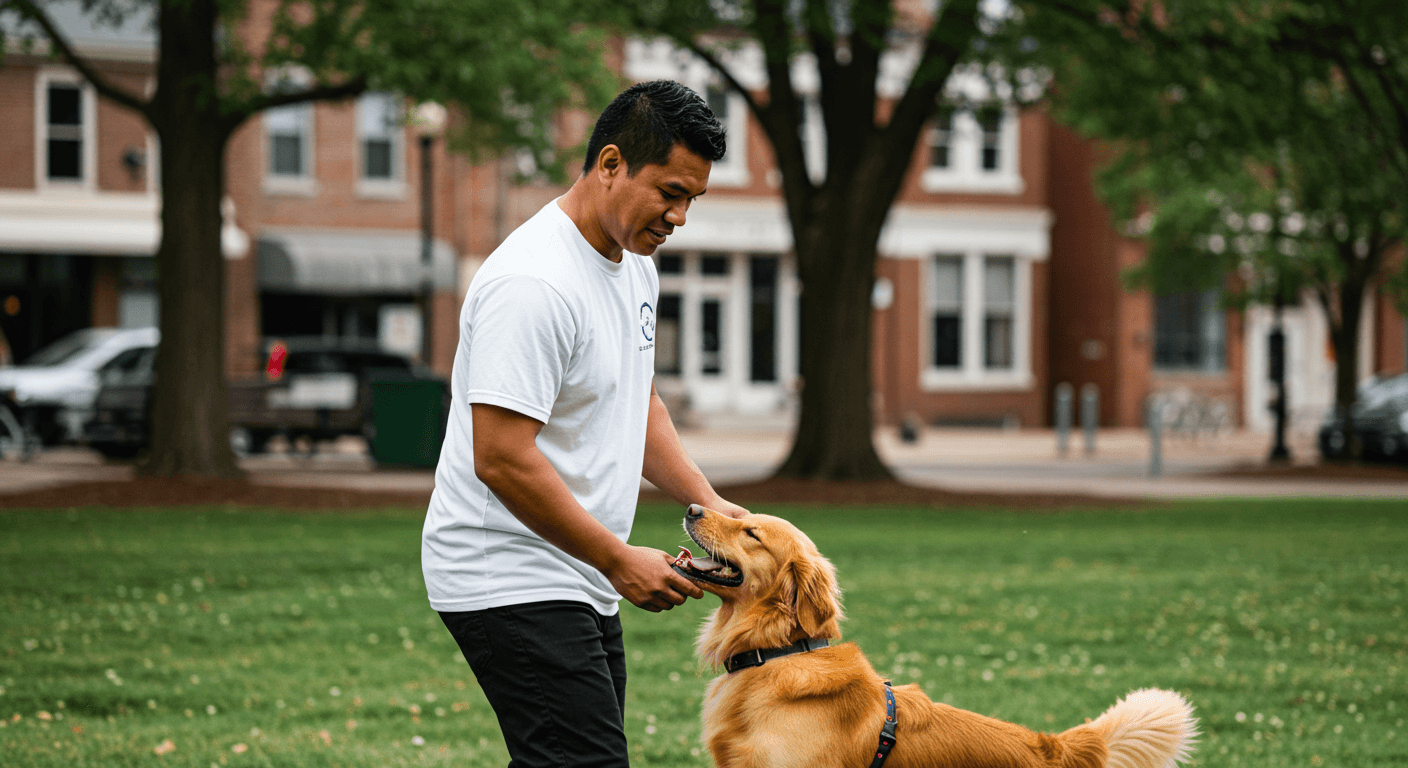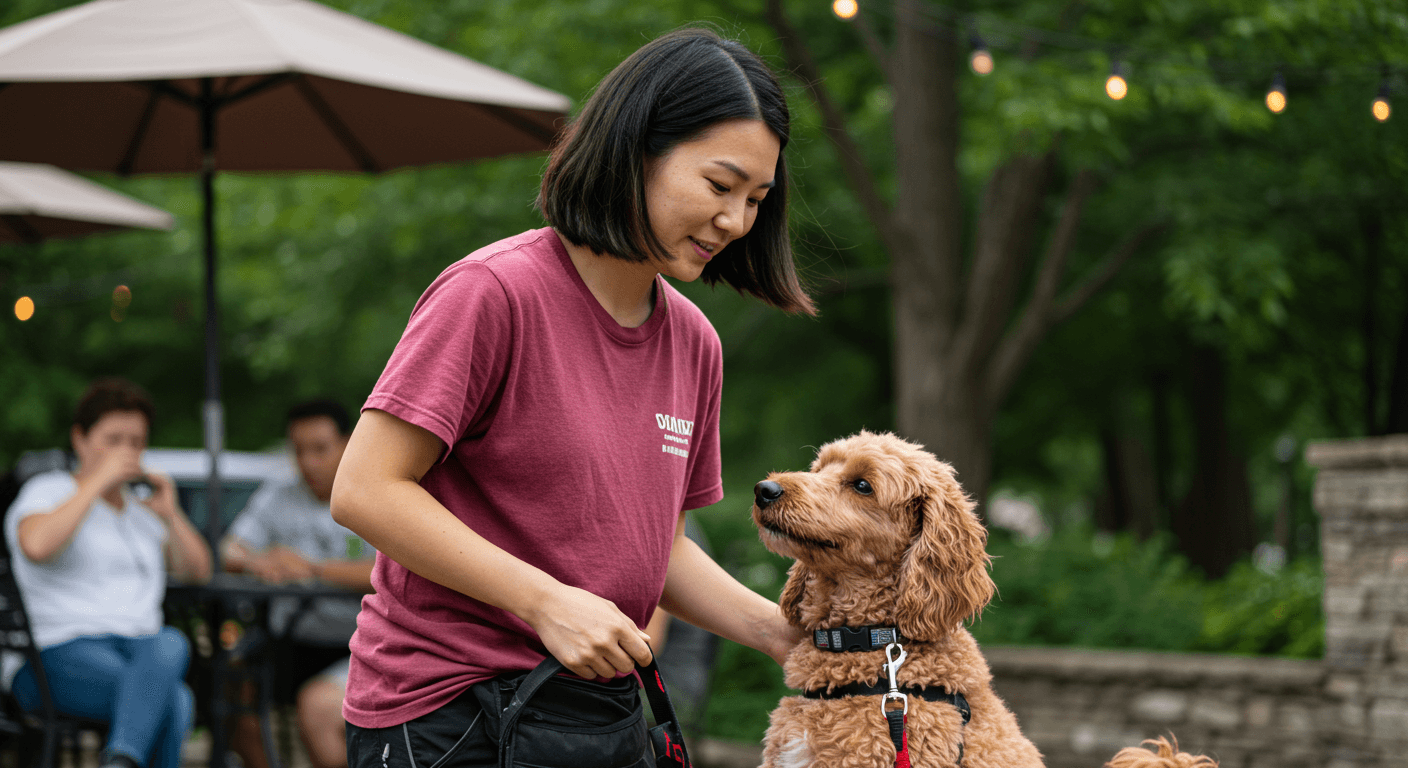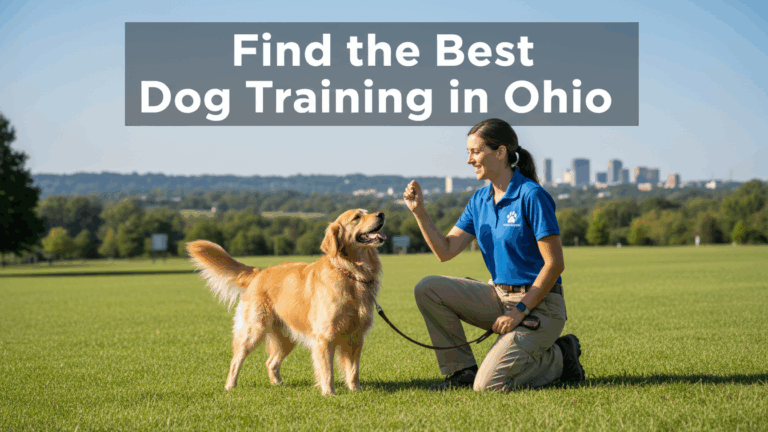Your Complete Guide to Choosing a Dog Trainer in Ohio
Ohio dog owners face unique challenges across the state, from navigating Cleveland’s busy urban parks to training dogs for quieter life in suburban Columbus neighborhoods or rural Appalachian trails. Your dog needs to handle everything from unpredictable Midwest spring weather to busy summer festivals, crowded farmers markets, and winter snow that demands solid recall skills.
Since Ohio has no statewide licensing requirements for dog trainers, finding the right professional means doing your homework. You’ll want someone who understands local leash laws, Ohio’s specific vaccination requirements, and how to prepare your dog for the lifestyle you actually live here.
How to Choose the Right Trainer
Start by looking for a professional who uses positive reinforcement training and can help you set realistic goals for your Ohio lifestyle. Whether you’re preparing for walks along the Scioto Mile in Columbus, handling crowds at Cincinnati’s Fountain Square, or practicing recalls at Cleveland Metroparks, your trainer should focus on building skills that work in real-world situations.
Credentials give you a quick way to compare experience levels and expertise. Look for trainers with dog trainer certifications like CPDT-KA, KPA-CTP, or IAABC-CDBC for serious behavior problems. If your dog shows aggression or extreme fear, ask about CBCC-KA certification or other science-based programs like CTC.
In-home dog training works best for puppies learning house manners, door greetings, and neighborhood walking skills. Group classes make sense once your dog can focus around distractions, which helps before you tackle busy public spaces.
Ask about the trainer’s approach to common Ohio challenges like winter indoor training when outdoor practice is limited, dealing with seasonal allergies that might affect your dog’s focus, or preparing for crowded summer events. A trainer who knows the state well will adjust their program based on where you live and what you actually do with your dog.
Common Dog Training Methods Explained

Positive reinforcement training builds trust while creating lasting behavior changes that hold up in busy Ohio environments. This approach also helps you stay within local leash laws and noise ordinances without relying on fear or intimidation.
Basic obedience covers sit, down, stay, place, recall, and leash training so your dog can handle walks, restaurant patios, and public spaces without pulling or jumping. These skills form the foundation for everything else.
Puppy training focuses on socialization, potty training, bite control, crate comfort, and early leash skills. Starting young prevents bad habits before they take root, which saves you time and frustration later.
Behavior modification addresses fear, reactivity, resource guarding, and separation anxiety through careful desensitization and counterconditioning. For serious cases, ask if your trainer works with local veterinarians who can rule out medical issues or prescribe medication when needed.
Private lessons and in-home sessions let you customize everything around your daily routines and your dog’s specific triggers. Day training speeds up results when you’re short on time, since the trainer works with your dog during the day and then teaches you how to maintain the progress.
Dog training classes help your dog practice good manners around other dogs and people. The best group classes screen participants carefully, give dogs plenty of space, and teach calm behavior rather than just excitement.
Specialized training like service dog training or therapy dog training requires extra structure, public-access skills, and a very clear step-by-step training program. These programs take months to complete and demand consistent practice in many different environments.
Stay away from trainers who use fear, intimidation, or pain to get results. Humane methods are safer for everyone, easier to maintain long-term, and much better for building a well-behaved dog you can trust in any situation.
Average Cost of Dog Training in Ohio (Updated for 2025)
Prices across Ohio vary based on the trainer’s experience, session length, location, and whether you’re in a major metro area or smaller town. Here’s what most Ohio dog owners are paying in 2025.
| Service Type | Average Cost (Ohio) |
|---|---|
| Puppy classes (4-6 weeks) | $140-$260 total |
| Group obedience classes (4-6 weeks) | $150-$280 total |
| Private lessons (60-90 min) | $100-$175 per session |
| In-home coaching packages (4-6 visits) | $400-$850 total |
| Day training (trainer works your dog) | $400-$900 per week |
| Behavior consult for reactivity/anxiety | $140-$230 initial |
| Board and train (2-4 weeks) | $1,800-$4,200 total |
You’ll probably pay extra travel fees if you live outside a trainer’s normal service area, and expect higher rates for complex behavior modification work that requires specialized knowledge.
Make sure you understand what’s included in the cost, how the professional dog trainer tracks progress, and whether they offer a free consultation or free evaluation before you commit to a full program.
Questions to Ask a Potential Dog Trainer
- What training methods do you use, and how do you keep training sessions positive and low-stress for my dog?
- What certifications or credentials do you hold, and do you pursue continuing education like CPDT-KSA?
- How will you customize the training program for my dog’s specific needs and our Ohio lifestyle?
- Do you offer in-home visits, dog training classes, or day training, and which approach fits my goals best?
- How will we measure my dog’s progress and know when to add more distractions or new environments?
- What are the total costs including travel fees, and what’s your cancellation policy?
- Do you carry liability insurance, and can you show me proof of coverage?
- For behavior problems, will you work with my veterinarian if medication or medical evaluation is needed?
- What should I practice between our sessions to help my dog keep improving?
- Can you provide references from other Ohio clients who had similar goals?
Local Ohio Rules and Considerations
Ohio law doesn’t require statewide dog licensing, but many cities and counties have their own registration and licensing requirements. Check with your local municipality to see what applies in your area.
Leash laws vary by city and county across Ohio. Most municipalities require leashes in public spaces except inside designated off-leash dog parks. Cleveland, Columbus, Cincinnati, and Toledo all enforce leash laws in parks, on trails, and in public areas.
Ohio Revised Code Section 955.22 requires all dogs over three months old to have current rabies vaccination. You’ll need to keep the rabies tag on your dog’s collar at all times, and your veterinarian will provide documentation. Find more details through the Ohio Department of Health.
Excessive barking can violate local noise ordinances in most Ohio cities and towns. Work with your trainer on alert barking and separation anxiety before neighbors file complaints with animal control.
Ohio doesn’t require professional dog trainers to hold special licenses or certifications. Anyone can legally call themselves a dog trainer, which is why checking credentials and experience matters so much.
If your trainer uses public parks or facilities for commercial training sessions, they may need permits and proof of liability insurance from the local parks department or city government.
Dog bites trigger specific legal requirements in Ohio. Under Ohio Revised Code Section 955.28, dog owners are strictly liable for injuries their dogs cause, which makes proper socialization and training even more important for your protection and your dog’s safety.
Local Ohio Resources for Dog Owners
These locations give you great places to practice obedience training, work on recalls, and provide safe enrichment for your dog. Always follow posted rules and local etiquette guidelines.
- Alum Creek Dog Park in Columbus offers separate fenced areas for large and small dogs with plenty of space for recall practice and socialization.
- Lake Erie dog beaches in Cleveland Metroparks and Lakewood allow leashed dogs on certain beach areas seasonally, which provides excellent distraction training opportunities.
- Sharon Woods Dog Park in Cincinnati features wooded trails and open play areas where you can practice focus around wildlife and other dogs.
- Cuyahoga Valley National Park welcomes leashed dogs on most trails, offering hundreds of miles for building loose-leash skills around hikers, cyclists, and natural distractions.
- Ohio State Parks allow leashed dogs in most day-use areas, campgrounds, and trails, which gives you countless options for practicing good manners in new environments.

FAQs
How much does in-home dog training cost?
Most Ohio trainers charge $100-$175 per in-home visit, with package discounts available when you buy multiple sessions. Behavior problems typically start at the higher end of that range because they require more expertise.
Is in-home dog training worth it?
Absolutely, because you’re working on problems exactly where they happen. Your trainer can address door manners, jumping on guests, counter-surfing, and yard reactivity in your actual home, then step outside to practice leash skills on your real neighborhood sidewalks.
Can you pay someone to house train your dog?
Yes, many trainers offer puppy programs that include potty training, crate routines, and daily schedules. Day training can speed up the process while teaching you how to maintain the results.
What is the 3-3-3 rule for dog training?
This timeline helps you understand adjustment periods for new or adopted dogs: expect about 3 days for your dog to decompress, 3 weeks to learn your routines, and 3 months to feel completely settled. Good dog training services work with this natural adjustment period rather than against it.
How long will it take to reach my training goals?
Most puppies and friendly adult dogs show solid progress within 4-8 weeks if you practice daily. Fear, reactivity, or aggression typically requires several months of careful behavior modification with gradual increases in difficulty.
What should I bring to group classes?
Pack a flat collar or harness, a 6-foot leash, high-value treats, water, and current vaccination records if your trainer requests them. Leave retractable leashes at home for safety reasons.
What’s the leash law in Ohio?
Leash laws vary by city and county, but most Ohio municipalities require dogs to be leashed in public spaces except inside designated off-leash areas. Check your local ordinances for specific requirements where you live.
Do I need a dog license in Ohio?
Ohio doesn’t require statewide dog licensing, but many cities and counties have their own registration requirements. Contact your local animal control office or city clerk to find out what applies in your area.
What shots does my dog need in Ohio?
Ohio law requires rabies vaccination for all dogs over three months old. Your veterinarian may also recommend distemper-parvo, bordetella, and other vaccines based on your dog’s lifestyle and exposure risks.
Are dog trainers required to be licensed in Ohio?
No, Ohio doesn’t require dog trainers to hold special licenses or certifications. Trainers follow normal business regulations, but anyone can legally offer dog training services regardless of their education or experience level.
Where can I practice off-leash recall?
Use fenced dog parks to keep things safe and legal while you’re building reliable recall skills. Many Ohio cities have enclosed dog parks specifically designed for off-leash practice.
Which dog parks allow training around Ohio?
Most public dog parks welcome training for dogs as long as you’re not running a commercial class without permission. Popular options include Alum Creek Dog Park in Columbus, Sharon Woods in Cincinnati, and numerous Cleveland Metroparks dog parks.
What beaches or trails allow dogs for training?
Cuyahoga Valley National Park allows leashed dogs on most trails, providing excellent opportunities for distraction training. Lake Erie beaches in the Cleveland area permit leashed dogs seasonally, and Ohio State Parks welcome leashed dogs in most day-use areas. Always check current park regulations before visiting.
How do I find expert dog trainers near me?
Look for trainers with recognized certifications, positive reviews from local clients, clear training methods, and experience with your specific goals. Ask for a free evaluation to see if their approach matches what you need.
What if my dog has separation anxiety?
Separation anxiety requires specialized behavior modification that gradually teaches your dog to feel comfortable alone. Work with a certified dog trainer who has experience with anxiety cases, and ask whether they recommend working with your veterinarian for additional support.
The right combination of thoughtful planning, humane methods, and consistent practice in Ohio’s diverse environments will help your dog become a confident companion. Whether you’re navigating busy city streets, exploring state parks, or simply building better household manners, investing in quality training for dogs pays off for years to come.
